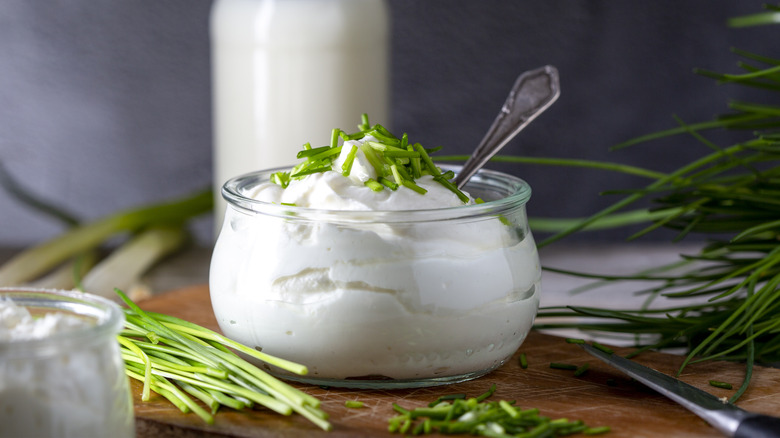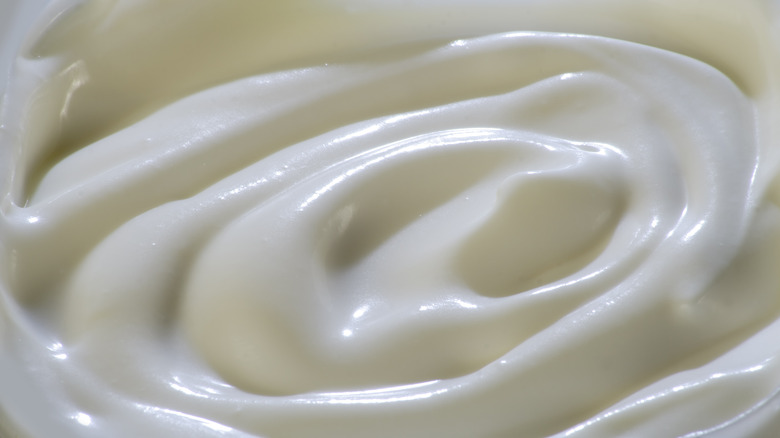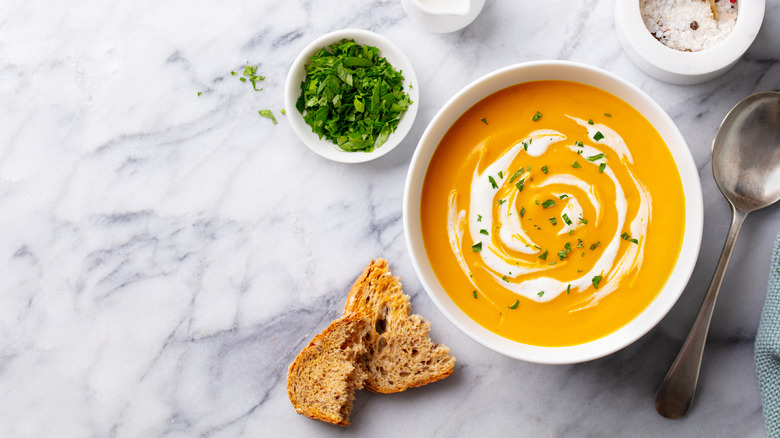The Subtle Difference Between American And European Sour Cream
Synonymous in the states with its dollop-able nature, sour cream is the perfect dairy product to scoop atop stews, including slow cooker chili, and it's just as delectable when whipped into creamy, tangy dips. With roots in Europe, sour cream was originally made simply with raw cream that had gone sour, and the resulting lactic acid from the natural bacteria in the spoiling dairy milk created a thickened texture and tart flavor.
Multiple types of sour cream are traditionally beloved across Europe, with a variety of nomenclatures and nuanced regional differences, including smetana in Central and Eastern European countries, Norwegian Rømme, and perhaps most notably, French crème fraîche. Today, commercially available sour cream is made from pasteurized cream that has been cultured using bacteria that generate lactic acid, which is then fermented to form the beloved thick, creamy ingredient, available to buy conveniently at the supermarket.
When choosing between a tub of American sour cream and the European stuff, you may be tempted to seamlessly swap one for the other since they are indeed quite similar creamy dairy products. Before doing so, however, it's important to note that many European sour creams have a higher fat and lower protein content, while American sour creams rely on a double homogenization process (plus sometimes additives and enzymes) to thicken the product. In fact, subtle differences in fat composition and texture greatly impact how sour creams from different regions taste and perform when used in the kitchen.
American versus European sour cream
European sour cream is naturally viscous and rich because of its high fat content, yet it is typically not quite as spoon-ably thick as the American stuff. To achieve a particularly luscious, thick consistency, American sour cream goes through a double homogenization process, in which heated milk is pushed through small openings, using pressure, to reduce the size of its fat droplets, to result in a creamy, emulsified dairy product.
In the U.S., full-fat sour cream must have at a minimum 18% fat, and some varieties of sour cream can run up to 25% fat. There are also low and reduced-fat varieties of sour cream available, which often use thickeners, gelling agents, and stabilizers to keep the product thick and scoopable. On the other hand, European varieties are typically higher in fat, around 30% or higher. This results in a richer, milkier flavor, with more grassy, dairy notes, compared to American sour cream which has a signature tart flavor that makes your mouth pucker — similar to the mouthfeel and taste of unsweetened Greek yogurt.
How to select the right sour cream for your recipe
To choose the best sour cream for your recipe, there are a few considerations to keep in mind, including preparation method and taste. For baking sour cream pound cake, or other cake, muffin, or pancake recipes, adding American sour cream to the batter will tenderize and moisten your sweet treats, since the acid in the cream prevents too much gluten development (which causes chewiness). American sour cream's tangy nature also makes for the perfect flavor combination when used as a base for veggie dips with salty chips.
When cooking with sour cream to make creamy butternut squash soup even more velvety and flavorful, it's best to use European sour cream varieties. Due to their higher fat content, these varieties will disperse and incorporate well into hot soup or stew and impart a depth of flavor and added richness. Most American sour creams on the other hand will form clumps when added to hot liquids and sauces (due to their high protein content, which will cause coagulating).
Both American and European sour creams are excellent for spooning on top of your favorite recipes. To top savory dishes like chili and baked potatoes, American sour cream will impart a perfectly tangy compliment. On the other hand, European sour cream's richer, dairy notes are accentuated when sweetened lightly and scooped right on top of a slice of homemade rhubarb pie, just like you would whipped cream.


